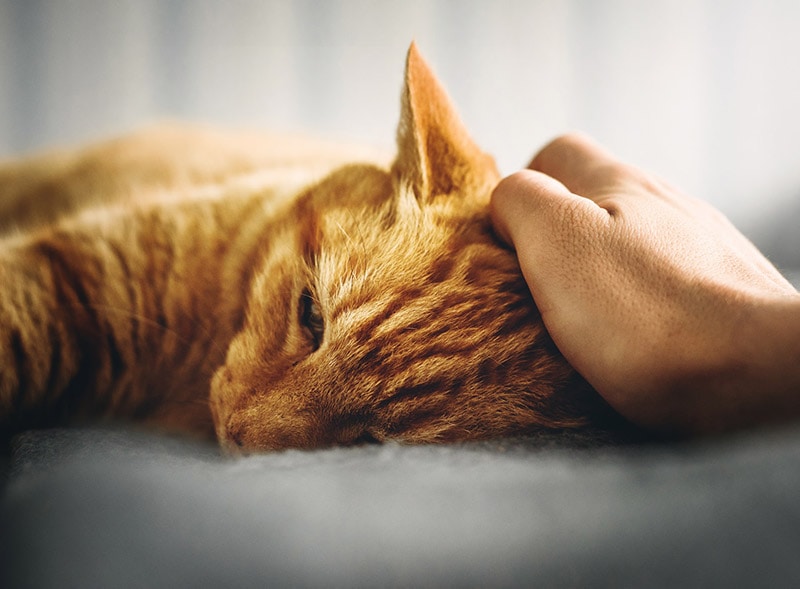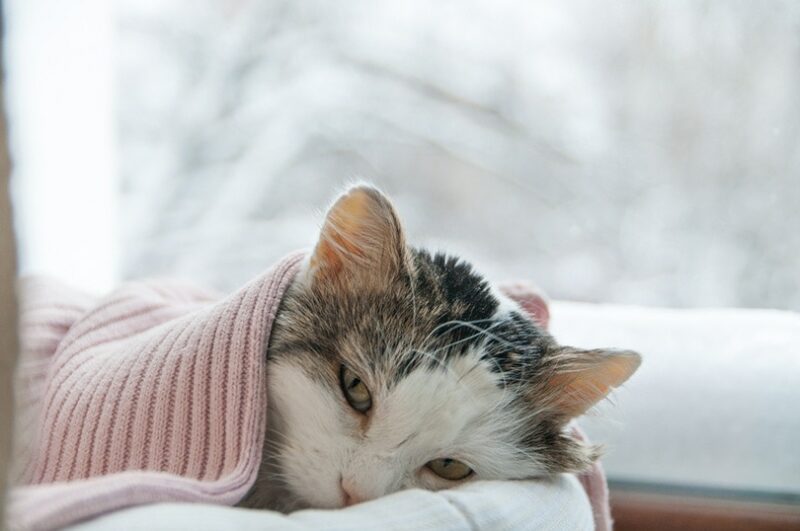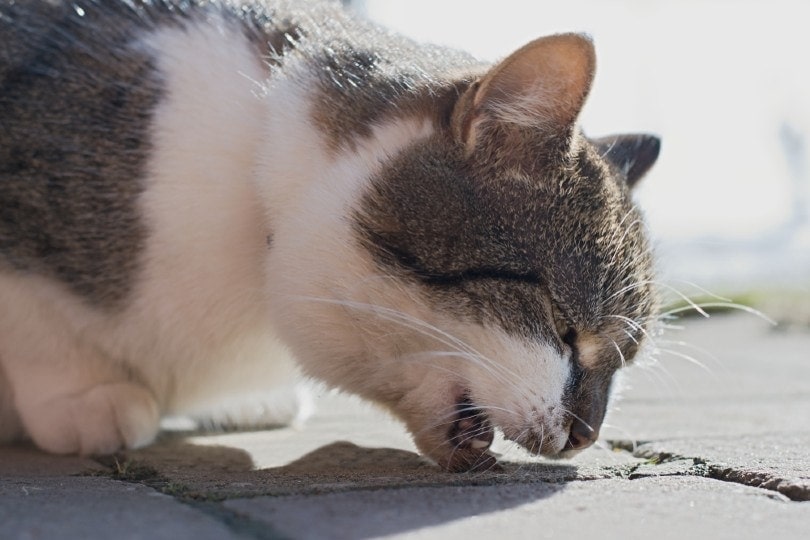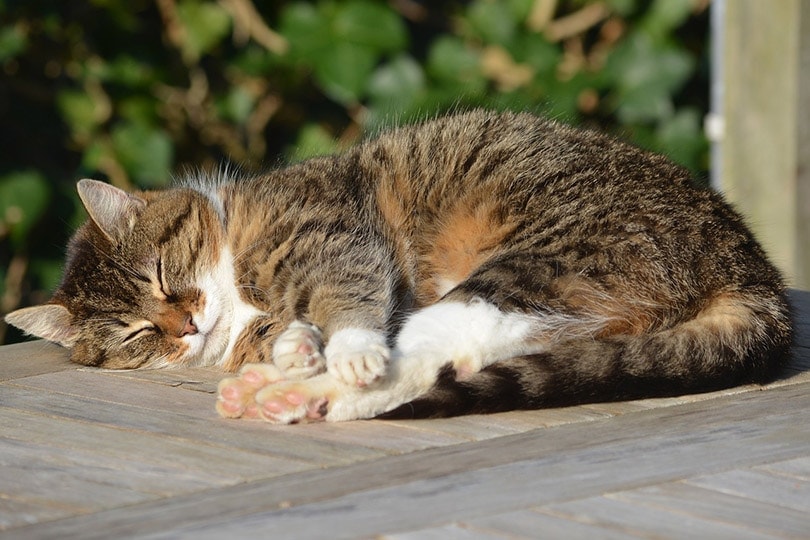Pneumonia in Cats: Causes, Signs & Treatments (Vet Answer)
Updated on

Click to Skip Ahead
Pneumonia refers to acute inflammation, often associated with infection of the alveoli (air sacs) and bronchioles (lower airways as they taper into the air sacs). It can affect one or both lungs. Infection at this level critically affects the site of gas exchange where oxygen is taken up and carbon dioxide released. Because of this effect, it’s not surprising that pneumonia can be life-threatening.
Various potential infectious agents or a combination of such infections exist, including bacteria, fungi, protozoa, and viruses. Worms are another important cause of pneumonia in cats, particularly in certain geographical regions.
What Is Pneumonia in Cats?
As mentioned above, a diagnosis of pneumonia in a cat refers to inflammation of the lower airways and air sacs resulting from an infectious process involving one or both lungs. The infection can be with bacteria, fungi, protozoa (one-celled organisms), or viruses. In some geographical areas, worms can also play a role in the development of pneumonia. Some patients can have co-infections. An example of this is a primary viral infection with secondary bacterial involvement because of the damage that the virus caused, promoting a favorable environment for bacterial growth. Other co-infections also exist, however.
It is worth mentioning that aspiration of gastric contents (gastric acid) results in pneumonitis. If this inflammation, in turn, promotes a bacterial infection, then this constitutes pneumonia rather than simply pneumonitis. Typically, cases of pneumonia are classified according to the infection that is present or by the underlying mechanism.

What Are the Signs of Pneumonia?
Some animals with pneumonia demonstrate no clinical signs; thus, the absence of any signs listed below does not rule out the possibility of pneumonia. Most cats with pneumonia show one or even several of the following clinical signs, depending on the degree of lung involvement and underlying clinical disease.
- Increased breathing rate and effort
- Coughing
- Nasal discharge with or without sneezing
- Anorexia
- Lethargy
- Exercise intolerance
In some cases, the onset of clinical signs can be a helpful clue as to a potential underlying cause. For instance, the acute onset of tachypnea (rapid breathing) can suggest aspiration pneumonia. More severe cases can present with dyspnea (difficulty breathing) or cyanosis (blue to purple discoloration of the gums/mucous membranes).
Fever might be present, given the presence of infection. However, some cats may also have a low temperature on presentation. Uncommon manifestations of pneumonia in cats include hemoptysis (coughing up blood) and sudden death.
Cats may also be presented to a veterinary clinic because of signs attributable to the underlying disease that led to pneumonia. These might include regurgitation, vomiting, or recurrent/persistent infections. In addition, cats may also have reduced food intake leading to reduced body weight and condition or a history of recent general anesthesia.
Abnormal lung sounds may be heard when listening to the lung fields using a stethoscope. However, more severe cases with lung lobe consolidation (i.e., more solid as they are not filled with air) may have areas without breath sounds.
What Are the Causes of Pneumonia?
Pneumonia can be classified according to the underlying disease process that led to its development or based on the identified infectious organism.
- Aspiration — associated with vomiting or regurgitation because of gastrointestinal or esophageal disease, or, in some cases, with recent general anesthesia
- Hematogenous — infection present elsewhere in the body spread to the lungs via the bloodstream
- Inhalation — breathing in an infectious organism, such as fungal spores
- Migrating foreign body — for example, a grass awn that migrates through the respiratory tract
While aspiration is a potential mechanism by which cats acquire bacterial pneumonia, it is crucial to understand that, in contrast to dogs, cats appear to be at lower risk for aspiration because of their more robust airway defense mechanisms. Regarding the prevalence of gastroesophageal reflux in cats during anesthesia, a recent study demonstrated a similar rate to that reported in dogs, with approximately 33% of cases undergoing anesthesia.
Inflammatory airway disease might be a risk factor for pneumonia in cats, as in humans. However, further research is required to confirm if such a link exists in our feline companions.
- Bacterial
- Mycotic (or fungal)
- Protozoal
- Verminous (involving worms)
- Viral
Common organisms in cases of bacterial pneumonia in cats include Pasteurella multocida, Escherichia coli, Klebsiella pneumoniae, Bordetella bronchiseptica, and Streptococcus canis. Typically, bacteria enter the lungs through the airways; however, hematogenous spread, albeit less common, is also possible. It is worth mentioning that Bordetella bronchiseptica is a bacterium that can cause pneumonia in cats without underlying risk factors or concurrent disease. In other words, it is considered a primary pathogen, which is typically not the case for the other bacteria listed above.
Verminous pneumonia can be because of either lungworms or non-lungworms. Examples of non-lungworms are intestinal worms, such as roundworms and hookworms. When these worms undergo migration through the lungs before the adult worms reach the intestine, they can cause verminous pneumonia. Such migration is more common in puppies but is possible in kittens and adult cats.

How Do I Care for a Cat With Pneumonia?
Treatment of pneumonia should ideally be based on either culture and susceptibility results or PCR testing, including obtaining samples from the airways and identifying which organisms are present and what treatments they are susceptible to. Culture and susceptibility testing is beneficial for bacterial pneumonia because, often, the bacteria present are resistant to empirical antibiotics.
While it is ideal to know what organism is present and what drug is likely to be effective, in some cases, the cat in question may be too critical to proceed with obtaining diagnostic samples. In such cases, management entails broad-spectrum antibiotics and close monitoring to determine response to treatment.
- Oxygen supplementation
- Intravenous fluids
- Saline nebulization and coupage
- Injectable medication, like antibiotics
In cases with mild clinical signs, these cats are typically managed on an outpatient basis with oral medications. Suppose an airway foreign body is suspected or identified with imaging. In that case, this needs to be removed, often with the aid of a bronchoscope. Still, surgery might be necessary in more complicated cases to remove the foreign material and remove severely affected lung lobes.
Treatment trials are often employed when lungworms are suspected because diagnostics have limitations when fecal shedding is intermittent. Cough suppressants are contraindicated in animals with bacterial pneumonia, as a cough is encouraged to expel airway secretions. If an underlying cause for why pneumonia developed is identified, it should be managed to limit potential recurrence.
Frequently Asked Questions
How Is Pneumonia Diagnosed in Cats?
Radiographs, also called X-rays, of the chest can be useful in identifying changes within the lung lobes that are suggestive of pneumonia. However, there are limitations when it comes to using this imaging modality. For example, the changes seen on X-rays often lag behind what is seen in a clinical setting. In other words, a cat may show signs of difficulty breathing but have only minimal changes on X-rays. The opposite is also true; with clinical improvement, the severity of the disease on X-rays may look worse than what the cat is showing clinically.
X-rays might also miss the presence of airway foreign bodies in around one-third of cases. A bronchoscopy to visualize any apparent areas of concern can help obtain samples and even reach a diagnosis. As mentioned, samples should be submitted for cytology, culture, and PCR testing. Computed tomography (or CT scan) helps offer superior detail and outline the extent of pneumonia but may not always be necessary. It is also important to perform a fecal examination for parasite ova or larvae causing verminous pneumonia, particularly in areas where worms are a more common cause of pneumonia.
In the case of aspiration pneumonia, it might also be necessary to investigate potential underlying esophageal or gastrointestinal diseases. Screening for possible causes of immunosuppression, such as feline leukemia virus and feline immunodeficiency virus, is also helpful.

Is Pneumonia Fatal in Cats?
While pneumonia, particularly if left untreated, can be life-threatening in cats, sudden death because of a diagnosis of pneumonia is uncommon.
Conclusion
Pneumonia is a potentially life-threatening condition in cats that can occur secondary to various underlying diseases. Different types of infections are possible, including bacterial, fungal, protozoal, viral, or verminous. Ideally, the treatment of pneumonia should be based on what underlying disease process is identified to limit further contribution and what infectious organism is present to provide a tailored treatment protocol for each patient, which will give the best opportunity to clear the infection.
Featured Image Credit: Alexander Andrews, Unsplash















